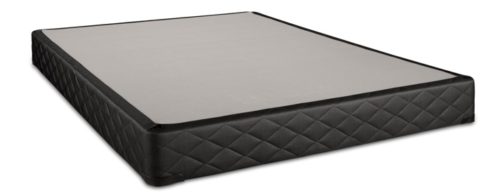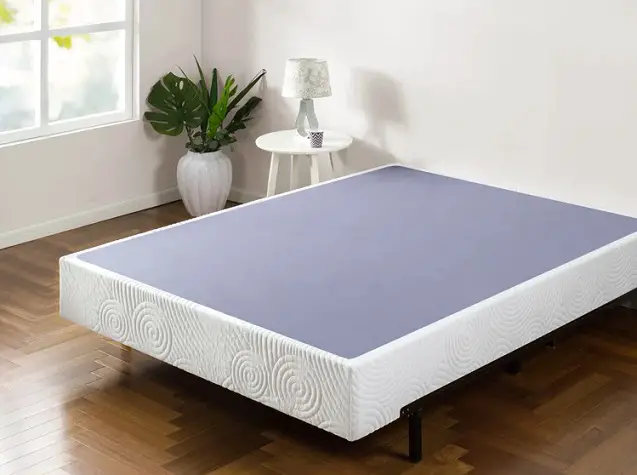The box spring and the bunkie board are used to provide support to the mattress in the bed. Bunkie boards are thin and lightweight measuring 1-3 inches while box springs are heavy and thick measuring 8-12 inches thick.
Box springs are usually used to lift the mattress as much as they give support while bunkie boards are for support only and do not offer any significant height to the mattress.
Bunkie boards are made of various materials and each material used to make the bunkie board will determine its characteristics such as weight support, durability, and aesthetics.
Table of Contents
What Materials Make Bunkie Boards?
Bunkie boards are made from various materials and the common ones with their characteristics are as follows.
1. Plywood
These are plies or sheets of wood that have been joined together at an angle to make them strong and lightweight. The plies are then glued together to make the plywood board.
Plywood is lightweight but strong enough to offer support to the mattress. The bunkie board made from plywood will be more expensive than the one made from particleboard. Being readily available you can easily DIY plywood bunkie board from home.
The disadvantage of plywood bunkie boards is that they do not last for long, typically 3-5 years. It is damaged by moisture and will swell deform and start rotting away.
2. Particleboard
Particleboards are made from wood waste such as sawdust, wood chips, and other wood waste. The articles are then mixed with glue and then hot compacted to form the board.
The particleboard is lightweight and cheap compared to plywood. The drawback is that due to the nature of how it is made, it cannot support as much weight as other forms of bunkie boards and will not last as long.
Usually, 3-5 years and is affected by moist environments where water is absorbed causing the particle board to swell and cause rotting.
3. Solid Wood
This is cut from the tree and no glue is applied. The solid wood board is strong, more durable, and carries more weight than plywood and particle boards. It is also heavier than the two.
Solid wood is also affected by moisture and will expand if used in a moist environment and contract when the environment is dry. Water absorption will cause the solid wood bunkie board to deform and become uneven.
4. Metal
Metal sheets are joined in a frame to form a bunkie board. They are spaced out in slats and then a sturdy cloth is put on top for one continuous piece.
Metal bunkie boards are long-lasting, lasting more than 20 years with good usage.
They are the strongest bunkie boards and support the greatest weight. The main drawback is that they are heavier and bulkier though they can be made in splits.
What Is Box Spring Made Of?
Box springs are made of a wooden or metallic frame that has springs inside and is then covered in skid-resistant fabric. The box spring is designed with the sole purpose of extending the mattress’s life by absorbing some of the shock directed at the mattress and providing support.
The tension and height of the spring will vary from one box spring to the other. The presence of a clothing cover allows free movement of air and enables the mattresses to breathe to avoid the formation of molds.
A box spring can be placed on the bed frame or the floor. It has height and will add height to the mattress making it easier to get in and out of the mattress.
Box springs are not the best for foam, latex, and hybrid mattresses.
Advantages Of A Box Spring
Though box springs are being phased out, they have distinct advantages such as:
- They provide good air flow to the mattress
- They are usually lightweight and when they come in split, they are easy to transport
- They provide great support to the mattress and are good for shock absorption
- They are the best for innerspring mattresses
- The presence of springs adds bounce to the mattress.
Disadvantages Of Box Spring
There are also some drawbacks to the box spring and these include;
- They are not compatible and are not the best for foam mattresses and latex mattresses
- The spring coils will break with time
- The box spring can start to sag with time
- It is costly to acquire
Box springs will come with various height specifications such as standard height which is 9 inches high, low profile box spring which is 5 inches high, and ultra-low profile which is 2 inches high.
Why Choose Bunkie Board Over Box Spring?
The choice of a bunkie board over a box spring may be personal but some of the choices may be informed by
1. Weight
Bunkie boards are lighter than box springs. The bunkie board is 1-2 inches high while a box spring may be as high as 9 inches. The extra height adds more weight to the box spring. The spring coils making the box spring are metallic and add to the overall weight.
This extra weight will add to the overall weight of the bed while the bunkie board will not add significant weight to the bed.
2. Compatibility
Bunkie boards will be compatible with different types of mattresses. Memory foam and latex mattresses are especially compatible with bunkie boards.
Box spring is not well compatible with foam and latex mattresses and may cause more damage to the mattress than the support they provide.
3. Portability
Bunkie boards are lightweight and moving them from one place to another is easy compared to box springs. Due to their bulk nature, it is not easy to move box springs from one point to the other.
Bunkie board can be fitted in tight places where a box spring cannot fit in
4. Price
A bunkie board is made of cheap readily available materials thus making them cheap. A box spring will have to undergo a comprehensive manufacturing process making it more expensive.
5. Assembly
Some box springs will require assembly to be done before they can be used while bunkie boards will require no assembly at all.
6. Durability
Box springs tend to get damaged faster and sag. The springs can lose their tension after a short while and not provide support as anticipated.
Bunkie boards tend to last longer than box springs and will retain their shape for a long.
Can A Bunkie Board Be Put On Top Of Box Spring?
Yes. A bunkie board can be put on top of the box spring. This is more where you want to add height to your mattress but at the same time want to put foundational support to the mattress.
You can also put a bunkie board on a box spring when the clothing covering the box spring is torn and the coil springs are protruding and are likely to damage the mattress.
The bunkie board will cover the coil springs and protect the mattress and give the needed support.
A bunky board on top of a box spring will make it less squeaky and give you more comfortable sleep. When you put a flat bunkie board over the box spring, it will ensure there is an even distribution of weight over the box spring.
Final Thoughts
Though the bunkie board and box spring are made using different technologies, they do provide great support to the mattress and each has its own unique needs it meets. The two can be used together to achieve even greater results and provide a more comfortable sleep experience.


